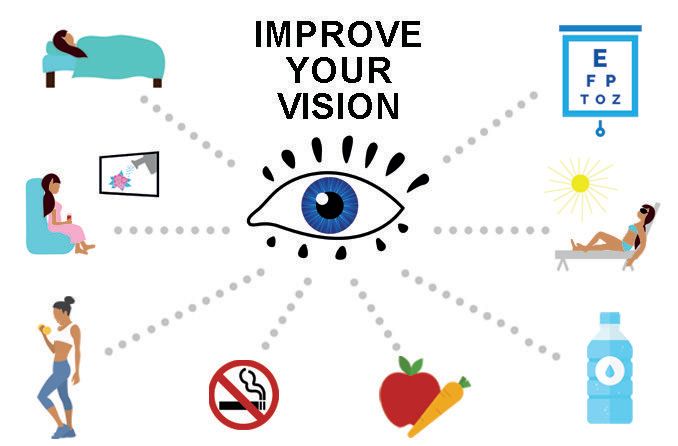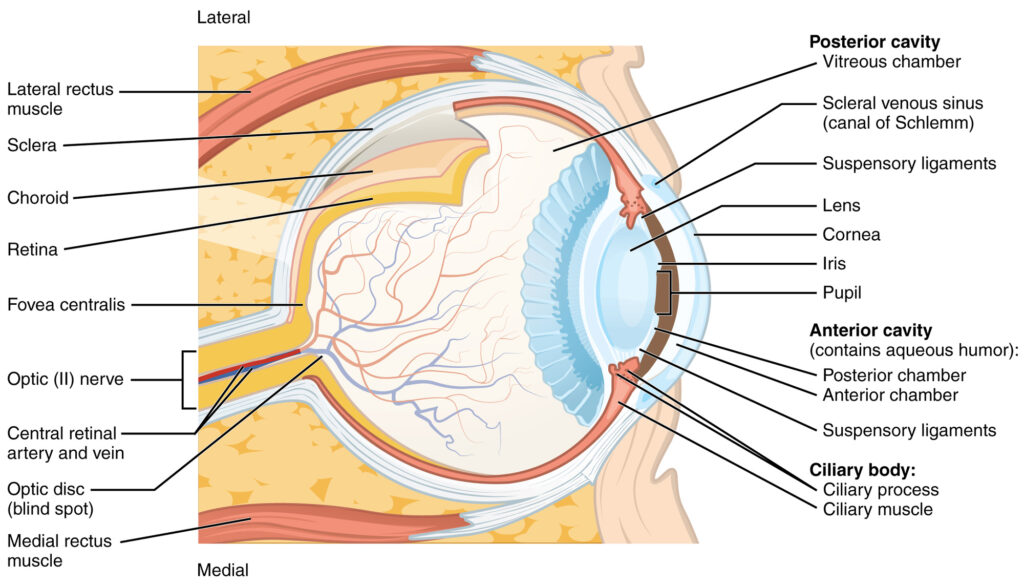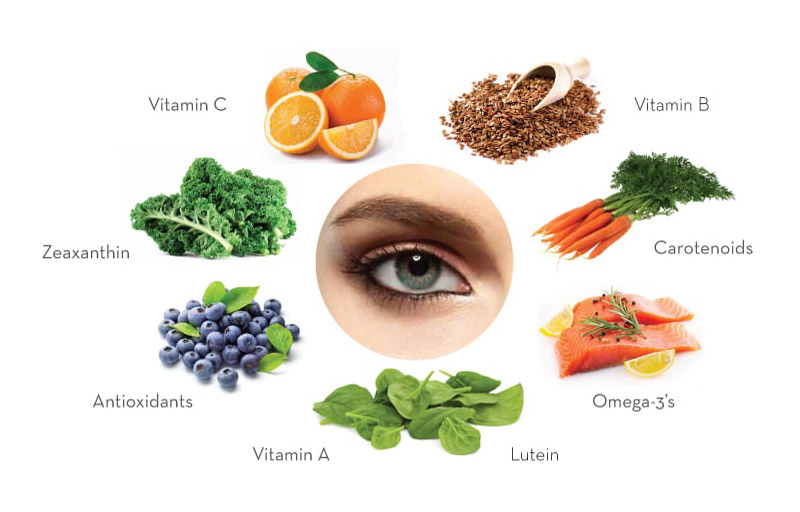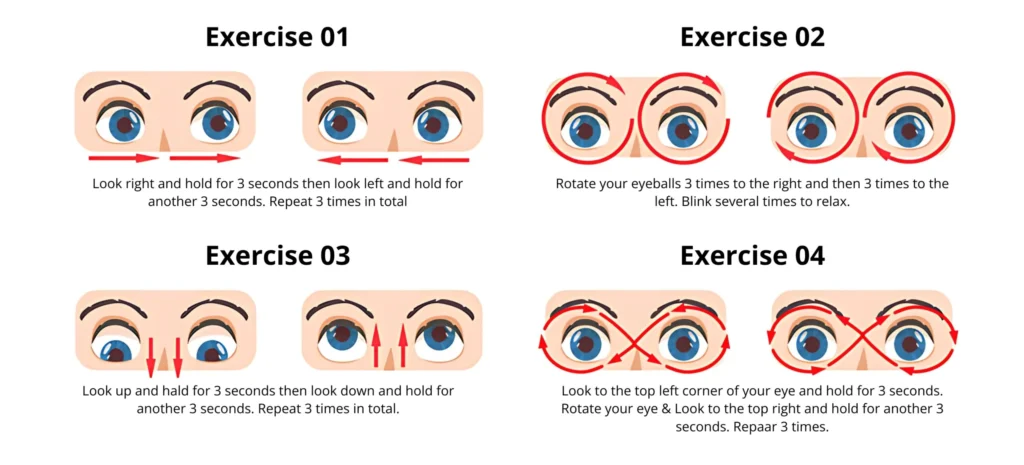
Natural eye health focuses on strengthening vision through nutrient-rich foods, healthy habits, eye exercises, and protective measures. These approaches reduce strain, support tear quality, prevent long-term damage, and help maintain clear, comfortable vision in today’s screen-heavy environment.
Key Takeaways
- Regular eye exams ensure early detection of vision problems and strengthen long-term eye health.
- Essential nutrients including vitamins A, C, E, zinc, selenium, lutein, zeaxanthin, and omega-3s support retinal health, reduce oxidative stress, and enhance tear film stability.
- Daily habits limiting screen time, using the 20-20-20 rule, exercising, staying hydrated, sleeping well, and avoiding smoking help lower the risk of strain and age-related eye issues.
- Eye exercises such as blinking, palming, focus shifting, and eye rolling reduce fatigue and improve muscle flexibility.
- UV-protective sunglasses and environmental adjustments like proper lighting and humidifiers protect against dryness and external irritants.
Introduction to Natural Eye Health Improvement
Eyes face constant stress from daily screen use, environmental pollutants, and the natural aging process. These factors can strain the eyes, reduce tear quality, and lead to vision problems over time. Natural care focuses on supporting the eyes through proper nutrition, lifestyle habits, and protective measures that reduce damage and maintain eye function. Unlike relying solely on medications or surgery, natural approaches empower individuals to nurture their eye health with minimal side effects.
By incorporating balanced diets rich in antioxidants and essential nutrients, practicing regular eye exercises, limiting screen time, ensuring adequate sleep, and protecting eyes from harmful UV rays and pollution, people can preserve their eyesight longer. Staying hydrated also ensures proper tear production and lubrication. Natural eye health improvement blends these habits into daily life, offering a holistic path to clear vision and reduced risk of age-related eye diseases. This mindful care is crucial in today’s digital and environmental landscape for maintaining optimal vision and eye comfort long-term.
Understanding Eye Anatomy and Vision Function Basics

The eye converts light into electrical signals the brain can interpret as images. Several key structures work together to make this possible.
- The tear film covers the eye surface, keeping it moist and protected from dust and infection. It also provides a smooth surface for light to pass through clearly.
- The retina is a thin layer at the back of the eye containing special cells called photoreceptors. These cells detect light and color, converting them into electrical impulses.
- The optic nerve carries the electrical impulses from the retina to the brain, where they are processed into the images we see.
Essential Nutrients and Foods for Eye Health

Certain nutrients are vital for maintaining strong, healthy eyes and protecting them from damage over time. These nutrients support tissue repair, reduce oxidative stress, and improve tear quality, all crucial for clear, comfortable vision.
- Vitamin A: This vitamin is crucial for the health of photoreceptors in the retina that allow the eyes to adjust to light and see in dim conditions. Deficiency can cause night blindness and dry eyes. Vitamin A is found mainly in animal products like liver, egg yolks, and dairy, as well as plant-based sources (carrots, spinach, kale) that provide provitamin A carotenoids converted into active vitamin A by the body.
- Vitamin C: A powerful antioxidant that protects eye tissues from oxidative stress and supports blood vessels supplying the eye. Sources include citrus fruits, peppers, broccoli, and strawberries. Vitamin C helps lower risks of cataracts and slows macular degeneration.
- Vitamin E: Important for guarding the retina’s fatty acids against oxidative damage. Foods rich in vitamin E include almonds, sunflower seeds, and vegetable oils. Vitamin E works alongside other antioxidants like vitamin C to maintain eye cell health.
- Zinc: Essential for transporting vitamin A to the retina and for producing melanin, which protects the eyes. Zinc deficiency can lead to poor night vision. Good sources are oysters, beef, pumpkin seeds, and nuts.
- Selenium: Supports the function of antioxidant enzymes protecting the eyes from free radicals and age-related damage. Found in nuts, seafood, and whole grains.
- Lutein and Zeaxanthin: These carotenoids concentrate in the macula, filtering harmful blue light and preventing light-induced eye damage. Leafy greens like spinach and kale, along with eggs, corn, and peas, are rich sources. They act like natural sunglasses.
- Omega-3 Fatty Acids: Particularly DHA, they are structural components of retinal cells and improve tear film quality, which helps in preventing dry eye symptoms. Fatty fish such as salmon and mackerel are excellent omega-3 sources.
- Hydration: Drinking plenty of water keeps the tear film stable and eyes well lubricated, reducing dryness and irritation risks.
A diet rich in these nutrients through natural foods helps sustain eye health, protect vision, and reduce age-related eye conditions.
Lifestyle Habits Supporting Healthy Vision
Daily habits profoundly affect eye health and can either protect or harm vision over time. Adopting supportive lifestyle practices helps reduce strain, maintains clear sight, and lowers the risk of eye diseases.
- Avoid Smoking and Excessive Alcohol: Smoking introduces harmful toxins that damage eye tissues and increase the risk of cataracts, macular degeneration, and dry eye. Excessive alcohol can dehydrate the body, including eyes, impairing tear production.
- Moderate Screen Time and Use the 20-20-20 Rule: Prolonged screen exposure reduces blink rate, causing dryness and eye fatigue. The 20-20-20 rule advises every 20 minutes, look at something 20 feet away for 20 seconds to relax eye muscles and refresh tear film.
- Ensure 7-8 Hours of Quality Sleep: Sleep allows eyes to rest and repair. Poor sleep can lead to dryness, irritation, and blurred vision. Adequate rest supports eye tissue regeneration and reduces eye strain.
- Exercise for Good Blood Circulation: Physical activity improves blood flow throughout the body, including the eyes. Better circulation delivers oxygen and nutrients to eye tissues, lowering risks of conditions like diabetic retinopathy and glaucoma.
- Wear UV-Protective Sunglasses Outdoors: Ultraviolet rays from the sun accelerate lens clouding and retinal damage. Sunglasses that block 99% to 100% of UVA and UVB rays shield eyes and help prevent cataracts and macular degeneration.
- Regular Eye Exams to Detect Early Issues: Routine eye checkups identify vision changes or diseases in early stages when treatment is most effective. Those over 60 or with risk factors should have annual exams; others should have exams every 1-2 years.
Natural Eye Exercises and Techniques

Eye exercises are simple practices designed to strengthen the eye muscles, improve focus, and reduce eye strain. These techniques can be easily integrated into daily routines to enhance comfort and support eye health, especially for those spending long hours on screens or in visually demanding environments.
- Blinking Exercises: Blinking spreads tears evenly across the eye surface, keeping eyes moist and reducing dryness. When working on screens, blink consciously to restore moisture. A common exercise involves closing the eyes gently, squeezing them tightly for a couple of seconds, and then reopening slowly. Repeat this several times to stimulate tear glands.
- Palming: Palming relaxes tired eye muscles and promotes blood circulation. Rub your hands together to warm them, then gently cup your palms over your closed eyes without pressure. Breathe deeply and relax for about five minutes. This technique relieves strain and fatigue.
- Focus Shifting: This exercise improves the flexibility of eye focusing muscles. Hold a finger or pen about six inches from your face, focus on it, then shift your focus to an object several feet away. Alternate focus between near and far objects several times. This helps reduce eye fatigue and enhances visual clarity.
- Eye Rolling: Rolling the eyes in slow circular motions improves muscle flexibility and coordination. Look straight ahead, then slowly roll your eyes clockwise several times, followed by counterclockwise rotations. This reduces stiffness and relaxes ocular muscles
. - Yoga Techniques Targeting Eye Relaxation: Integrate gentle yoga poses and breathing exercises that encourage relaxation throughout the body including the eyes. Practices such as Trataka (steady gazing on a fixed point) enhance concentration and eye endurance.
Regular practice of these natural exercises can ease eye strain, promote muscular strength, and help maintain overall eye comfort and health without any side effects.
Herbal and Home Remedies for Eye Care
Natural herbs have long supported eye health through their antioxidant, anti-inflammatory, and circulation-boosting effects. Many traditional remedies use plant-based extracts to soothe irritation, protect delicate eye tissues, and improve blood flow.
- Bilberry and Ginkgo Biloba: Bilberry is rich in anthocyanins, powerful antioxidants that help protect the retina and improve night vision. Ginkgo biloba enhances circulation to the eyes, supporting oxygen and nutrient delivery, which may help reduce risks of glaucoma and macular degeneration.
- Chamomile and Aloe Vera: Both have soothing, anti-inflammatory, and moisturizing properties. They can be used as gentle eye compresses or in diluted forms to relieve redness and irritation. Aloe vera also supports skin and eyelid healing.
- Home Compresses: Applying cool compresses with clean water or soaked green tea bags can calm irritated eyes and reduce puffiness. Green tea contains antioxidants that may further benefit eye health.
- Professional Guidance: While many natural remedies are safe, it’s important to consult eye care professionals before use, particularly to avoid adverse reactions or interactions with medications. Self-medicating with herbs without guidance is not recommended.
Environmental and Behavioral Modifications
Changing the environment and habits reduces eye strain and dryness:
- Use Humidifiers: Increase indoor humidity in dry climates or air-conditioned rooms to prevent tear film evaporation and keep eyes moist.
- Avoid Smoke, Dust, and Chemicals: Reducing exposure to irritants lowers inflammation and preserves eye surface health.
- Proper Lighting: Ensure adequate ambient and task lighting to reduce eye strain and prevent headache or blurred vision.
- Protective Eyewear: Wear sunglasses with UV protection outdoors and safety glasses during sports or hazardous work to prevent injury and light damage.
These approaches combined provide a holistic, natural framework to protect and promote eye health daily.
Common Myths and Misconceptions About Eye Health
Eye health is often misunderstood due to widely circulated myths. Understanding the facts helps in adopting proper care and avoiding unnecessary worry.
- Myth 1: Reading in Dim Light Will Damage Your Eyes
While reading in low light causes your eyes to work harder, leading to temporary strain and fatigue, it does not cause lasting damage. The discomfort fades once you rest your eyes. - Myth 2: Wearing Glasses or Contacts Weakens Eyes
Corrective lenses help the eyes focus light properly but do not weaken eyesight. Not wearing prescribed glasses may cause headaches or strain, but won’t harm your vision permanently. - Myth 3: Carrots Give You Perfect Vision
Carrots provide vitamin A which is essential for eye function, but eating large quantities alone won’t improve vision. A balanced diet with multiple nutrients offers comprehensive support for eye health. - Myth 4: Extended Screen Time Damages Eyesight Permanently
Excessive screen use causes digital eye strain, dryness, and discomfort but does not cause permanent vision loss. Using ergonomic setups, taking frequent breaks, and blinking consciously helps prevent symptoms. - Myth 5: You Can “Wear Out” Your Eyes by Reading or Using Them Too Much
Eyes do not tire out permanently from use. Extended focusing may cause temporary fatigue, but proper rest and relaxation restore eye comfort. - Myth 6: Stronger Glasses Damage Vision
Wearing an incorrect prescription may cause discomfort or blurry vision temporarily but does not damage ocular structures or make vision worse. - Myth 7: Sitting Close to Screens or TVs Damages Eyes
Sitting close to screens does not physically harm eyes but may indicate underlying myopia or cause eye strain from focusing. Early vision testing helps detect issues. - Myth 8: Eye Conditions Always Show Symptoms Early
Many serious eye diseases such as glaucoma or diabetic retinopathy progress without noticeable symptoms. Regular comprehensive eye exams are crucial for early detection and treatment. - Myth 9: Eye Exercises Cure All Vision Problems
Eye exercises help reduce strain and improve muscle flexibility but do not correct refractive errors like nearsightedness or astigmatism, which need glasses or surgery. - Myth 10: Supplements Alone Restore Vision
Supplements support overall eye health and may slow disease progression but cannot reverse existing vision loss. They are most effective combined with a healthy lifestyle. - Myth 11: Only Older People Need Eye Exams
Eye exams are important at all ages, including childhood, to ensure healthy development and catch early problems. - Myth 12: Blue Light from Screens Causes Eye Damage
Blue light exposure can cause temporary discomfort and disrupt sleep but evidence shows it does not cause permanent retinal damage. - Myth 13: Contact Lenses Are Risk-Free
Improper contact lens hygiene can cause serious infections and corneal damage, so proper care and regular checkups are essential. - Myth 14: Vision Always Worsens with Age
While some decline in vision is common with age, many people maintain good eyesight through proper nutrition, protection, and regular care. - Myth 15: Squinting Improves Vision
Squinting improves focus momentarily but puts stress on eye muscles and does not improve vision long-term. - Myth 16: Smoking Does Not Affect Eyes
Smoking increases risk of cataracts, macular degeneration, and optic nerve damage due to oxidative stress and poor vascular health. - Myth 17: Eye Diseases Are Completely Genetic
Genetics are a factor, but lifestyle, nutrition, protection, and medical management significantly influence disease risk and progression. - Myth 18: Glasses Are Only for Reading or Seeing Far
Glasses correct vision but do not alter the physiology of the eyes or impair natural function. - Myth 19: Eye Drops Cure All Eye Problems
Eye drops relieve symptoms like dryness or redness but do not treat underlying diseases which require medical attention. - Myth 20: Only Eye Surgery Can Fix Vision Problems
Surgery is one option for refractive errors, but glasses, contacts, nutrition, and exercises also contribute to healthy vision. - Myth 21: Children’s Vision Will Naturally Outgrow Problems
Vision issues in children need professional assessment and correction to prevent permanent deficits. - Myth 22: Using Smartphones at Night is Harmless
Nighttime screen use disrupts sleep cycles and causes eye strain due to blue light exposure. - Myth 23: Eye Color Affects Vision Quality
Eye color has no impact on vision quality or risk for most eye diseases. - Myth 24: Vitamin Supplements Are Always Safe and Effective
Supplements can interact with medications or cause harm if not taken correctly. Medical advice is important before use. - Myth 25: Contact Lens Use Limits Outdoor Activities
With proper care, contacts are safe for most activities including sports and sun exposure. - Myth 26: Vision Improvement Supplements Work Instantly
Benefits from supplements develop gradually and support long-term eye health. - Myth 27: Aging Means Inevitable Blindness
Aging increases risk but blindness is not inevitable. Preventive care and treatments preserve vision.
FAQs
What vitamins are important for eye health?
Vitamins A, C, and E are essential antioxidants that protect eye cells from oxidative stress and support tissue repair. Vitamin A supports night vision and healthy photoreceptors. Zinc helps transport vitamin A in the retina and maintain visual pigments. Lutein and zeaxanthin filter harmful blue light and protect the macula. Omega-3 fatty acids support retinal cell membranes and tear production. A diet rich in colorful fruits, vegetables, nuts, and fish provides these nutrients naturally.
Can diet really improve vision?
While diet cannot reverse refractive errors like nearsightedness, it plays a crucial role in preventing or slowing age-related eye conditions such as macular degeneration and cataracts. Nutrient-rich diets supply antioxidants, vitamins, and minerals that protect retinal cells, reduce inflammation, and improve overall eye health, supporting clearer vision over time.
Do eye exercises help?
Eye exercises help relax and strengthen eye muscles, reduce strain, and improve focusing flexibility. Exercises such as blinking, palming, focus shifting, and eye rolling can alleviate digital eye strain and fatigue. However, exercises do not correct refractive errors or replace corrective lenses or surgery.
How often should I have an eye exam?
Adults should schedule comprehensive eye exams every 1 to 2 years to detect early signs of disease and update prescriptions. People over 60 or with risk factors like diabetes require annual exams. Children also need regular eye checkups to ensure proper vision development.
Does screen time harm my eyes permanently?
Prolonged screen use causes digital eye strain and dryness but does not induce permanent vision loss. Symptoms can be minimized with proper lighting, screen positioning, frequent breaks applying the 20-20-20 rule, and conscious blinking to maintain tear film.
Are supplements necessary for eye health?
Supplements can fill nutritional gaps and support eye health when diets are insufficient. However, they work best when combined with a balanced diet and healthy lifestyle habits. Excessive supplementation may have risks; consult healthcare professionals before starting supplements.
Can hydration affect dry eyes?
Staying well hydrated supports tear production and tear film stability, reducing dryness and discomfort. Drinking adequate water daily helps maintain eye moisture and prevents irritation.
Is protecting eyes from UV light important?
UV radiation contributes to cataracts and macular degeneration. Wearing sunglasses that block 99-100% of UVA and UVB rays outdoors protects eyes from harmful light and reduces age-related risks.
Can quitting smoking improve eye health?
Smoking accelerates oxidative damage, increasing cataract and macular degeneration risks. Quitting smoking improves blood flow and reduces oxidative stress, significantly lowering risk of vision loss over time.
Are herbal remedies effective for eyes?
Some herbs like bilberry and ginkgo biloba enhance ocular circulation and provide antioxidant protection. Aloe vera and chamomile soothe irritation. Natural remedies can support eye comfort but should be used cautiously under professional guidance as part of holistic care.
Conclusion
Maintaining healthy vision is critical in our screen-heavy, polluted world. Natural eye care focuses on balanced nutrition rich in vitamins and antioxidants, lifestyle choices like quitting smoking, regular exercise, quality sleep, and screen time management.
Protective measures such as UV-blocking sunglasses and regular eye exams help prevent age-related vision loss. Eye exercises alleviate digital eye strain, while herbs and environmental changes support comfort and health. These combined practices reduce eye damage, improve tear quality, and strengthen eye muscles for lasting clear vision without medication or surgery.
Reference
- National Eye Institute: Healthy Vision Tips
https://www.nei.nih.gov/learn-about-eye-health/nei-for-kids/healthy-vision-tips - Healthline: 10 Ways to Improve Your Eyesight
https://www.healthline.com/health/how-to-improve-eyesight - WebMD: Tips for Eye Health and Maintaining Good Eyesight
https://www.webmd.com/eye-health/good-eyesight - American Academy of Ophthalmology: Diet and Nutrition for Your Eyes
https://www.aao.org/healthy-eyes/caring-for-your-eyes/diet-and-nutrition - Mayo Clinic: Eye Health Myths and Facts
https://www.mayoclinichealthsystem.org/hometown-health/speaking-of-health/eye-health-myths-and-facts - Cleveland Clinic: Dry Eyes – Types, Symptoms, Causes & Treatment
https://my.clevelandclinic.org/health/diseases/24479-dry-eye - Kraff Eye Institute: 10 Best Foods to Improve Eyesight
https://kraffeye.com/blog/10-foods-to-improve-eyesight
Dr. Amiah Rainey researches diet–disease relationships with expertise in vitamins, minerals, and biomarker methods. She earned a PhD from Harvard T.H. Chan School of Public Health (2019) and completed a postdoctoral fellowship at the NIH/NIDDK. With ~20 peer-reviewed publications (example) and experience on NIH-funded cohort studies, Amiah translates complex evidence into practical guidance. She advises on study design, evidence grading, and data transparency. Profiles: ORCID, Google Scholar; list affiliations and any disclosures.

